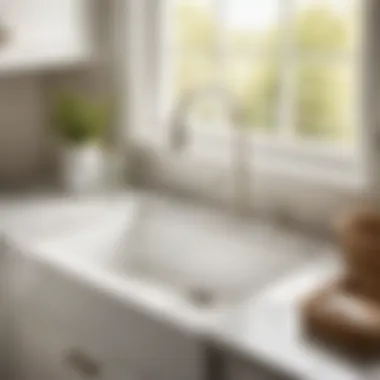A Comprehensive Guide to Choosing and Using a Narrow Laundry Room Sink


Materials:
- Stainless steel narrow laundry room sink (dimensions: 24 inches length, 18 inches width)
- Faucet suitable for compact sinks
- PVC pipes for drainage (1.5 inches diameter)
- P-trap assembly
- Sink clips
- Screws
- Plumber's tape
- Silicone sealant
- Adjustable wrench
- Screwdriver
- Drain wrench
- Level
- Measuring tape
DIY Steps:
- Preparation: Measure the designated space for the sink installation. Ensure the area can accommodate the sink dimensions without hindering movement and access.
- Placement: Position the sink in the desired location, marking where the sink clips will be installed for support.
- Cutting Holes: Create holes for the faucet and drainage using appropriate tools, ensuring precision to avoid leaks.
- Connection: Install the P-trap assembly to the main drainage line, connecting it securely to the sink's drain.
- Mounting: Secure the sink in place using sink clips and screws, ensuring stability and alignment.
- Faucet Installation: Connect the faucet to the sink according to the manufacturer's instructions, ensuring a tight and leak-free fit.
- Sealing: Apply plumber's tape to the pipe threads before connecting to prevent leaks. Secure all connections with silicone sealant.
Technical Aspects:
- Tools: Using an adjustable wrench, screwdriver, and drain wrench, you can efficiently handle the installation process.
- Timing: Allocate sufficient time for each step to avoid rushing and making mistakes. The entire process can take a couple of hours based on your skill level.
- Critical Techniques: Ensuring proper alignment during mounting, tight connections, and thorough sealing are crucial for a functional and durable sink installation.
DIY Project Process:
- Start with Preparation: Clear the area, gather all necessary tools and materials.
- Install the Drainage: Focus on connecting the P-trap assembly accurately to prevent future leaks.
- Mount the Sink: Secure the sink firmly using clips and screws, ensuring it sits level and aligns with the space.
- Attach the Faucet: Follow the manufacturer's instructions for a proper faucet installation, securing it tightly.
- Seal and Test: Apply silicone sealant to all connections, letting it cure before testing the sink for leaks.
Troubleshooting Tips:
- If you notice leaks, check the connections and seals for any gaps or looseness.
- Ensure the sink is level and properly aligned to prevent drainage issues.
- Double-check all connections and tighten if necessary to avoid future leaks.
- Seek professional help if faced with complex plumbing challenges.
Introduction
In the realm of household management and efficiency, every detail counts, from optimizing space utilization to streamlining daily chores. The heart of a functional laundry room lies in its centerpiece - the sink. This comprehensive guide embarks on a journey to unveil the untapped potential of a narrow laundry room sink, shedding light on its multifaceted benefits and practical applications
As we delve into the nuances of this essential element, we unravel a tapestry of possibilities that can transform a mundane chore into a seamless and gratifying experience. This article serves as a beacon for housewives and homeowners alike, offering a detailed roadmap to navigate the intricacies of selecting and utilizing a compact sink effectively
Within these virtual pages, readers will discover a treasure trove of insights, ranging from innovative design concepts that maximize utility to strategic installation techniques that amplify functionality. By the time you reach the conclusion of this guide, you will be equipped with the knowledge and expertise to elevate your laundry room space to new heights of efficiency and elegance.
Benefits of a Narrow Laundry Room Sink
In the realm of maximizing efficiency within a narrow laundry space, the importance of a well-chosen and utilized sink cannot be overstated. The compact nature of a narrow laundry room necessitates strategic decisions when it comes to fixtures, and the sink holds a pivotal role in this regard. By delving into the specifics of the benefits of incorporating a narrow laundry room sink, individuals can elevate the functionality and practicality of their laundry areas.


Space-saving Solutions
Innovative Design Concepts
Embarking on the journey of space-saving solutions within a narrow laundry room often involves embracing innovative design concepts. These design elements are meticulously crafted to optimize every inch of available space without compromising on functionality. From sleek, wall-mounted sink designs to cleverly integrated storage compartments, innovative design concepts are tailored to meet the unique challenges posed by compact laundry areas.
The key characteristic of innovative design concepts lies in their ability to blend form with function seamlessly. By choosing these design solutions, individuals can achieve a harmonious balance between aesthetics and practicality in their laundry spaces. One of the standout features of innovative design concepts is their adaptability to diverse room layouts, making them a versatile and popular choice for those seeking efficiency in a limited space. While the unique feature of innovative design concepts lies in their ability to maximize storage potential without overcrowding the room, it is essential to weigh the advantages and disadvantages carefully when selecting these options for a narrow laundry room sink.
Multi-functional Features
When exploring space-saving solutions for a narrow laundry room sink, multi-functional features emerge as a defining factor in enhancing utility and convenience. These features go beyond traditional sink functionalities to offer additional benefits that streamline laundry routines and maximize efficiency. From built-in drying racks to collapsible basin extensions, multi-functional features cater to the diverse needs of modern households.
The key characteristic of multi-functional features is their versatility, making them a valuable addition to any compact laundry space. By incorporating these features, individuals can transform their sink area into a multifaceted hub for various tasks, reducing the need for multiple appliances or accessories. The unique feature of multi-functional features lies in their ability to adapt to changing requirements, ensuring that the sink remains a dynamic and efficient component of the laundry room. While the advantages of multi-functional features are evident in their space-saving and organizational benefits, it is crucial to consider any potential drawbacks when integrating these elements into a narrow laundry room sink.
Choosing the Right Sink Size
In the realm of laundry room efficiency, selecting the appropriate sink size plays a crucial role in maximizing functionality and space utilization. The decision on the sink size is a fundamental step that can greatly impact the overall effectiveness and aesthetics of the laundry area.
Factors to Consider
Room Layout
When deliberating on the ideal sink size for your laundry room, room layout stands out as a pivotal factor to contemplate. The arrangement of your space dictates the dimensions available for a sink, influencing how well it integrates into the existing design. A well-thought-out room layout ensures seamless incorporation of the sink, optimizing accessibility and workflow. Consider the location of plumbing lines and existing cabinetry to ensure a harmonious fit for the chosen sink size.
Utility Needs
The consideration of utility needs is paramount when determining the appropriate sink size for your laundry room. Assessing the frequency and volume of usage will guide you in selecting a sink that caters to your specific requirements. If frequent large loads are a norm in your household, a larger sink size may be more practical and efficient. Conversely, smaller sink sizes are suitable for light usage or compact spaces, ensuring optimal functionality without overwhelming the area.
Design Preferences
Delving into design preferences adds a layer of personalization to the utilitarian aspect of sink selection. Your design preferences encompass aspects such as aesthetics, material choices, and overall style cohesion with the existing interior design. Opting for a sink size that aligns with your design preferences fosters a harmonious blend within the space, enhancing the visual appeal of your laundry room. Consider factors like color, texture, and finish to achieve a cohesive and visually pleasing laundry area.
Optimizing Utility


In the pursuit of maximizing efficiency and functionality within a narrow laundry room space, optimizing utility plays a crucial role. This section aims to highlight the significance of strategically utilizing the available space to its full potential and streamlining the workflow in the laundry area. By exploring various installation techniques and options, homeowners can tailor their laundry room sink setup to best suit their needs.
Installation Techniques
Wall-mounted Options
Wall-mounted sink options offer a space-saving solution for narrow laundry rooms by eliminating the need for a bulky base cabinet. This technique involves attaching the sink directly to the wall, freeing up valuable floor space for other essential laundry appliances or storage. The key characteristic of wall-mounted sinks is their compact design, making them an ideal choice for maximizing utility in a limited area. Their installation height can be customized to the user's convenience, catering to ergonomic preferences and ease of use. One unique feature of wall-mounted options is their flexibility in placement, allowing for strategic positioning that optimizes workflow efficiency. However, a potential disadvantage is the limited storage space beneath the sink compared to traditional base cabinet setups. Overall, wall-mounted options are favored for their sleek appearance, ease of installation, and ability to enhance the functionality of a narrow laundry room.
Under-counter Placement
Opting for under-counter sink placement involves installing the sink beneath a countertop, seamlessly integrating it into the laundry room's layout. This technique is popular for its ability to maintain a clean and cohesive aesthetic while maximizing counter space for sorting, folding, and other laundry tasks. The key characteristic of under-counter placement is its seamless blending with the surrounding cabinetry, creating a unified look in the laundry area. This choice is beneficial for homeowners seeking a modern and organized laundry space. Additionally, the unique feature of under-counter placement lies in its convenient accessibility and ergonomic design, allowing users to work comfortably around the sink. However, potential disadvantages include limitations in customization compared to freestanding sink options and potential challenges in installation complexities. Overall, under-counter placement offers a stylish and functional solution for optimizing utility in a narrow laundry room setting.
Enhancing Functionality
In this detailed guide on maximizing efficiency through the selection and utilization of a narrow laundry room sink, the aspect of enhancing functionality takes center stage. Enhancing functionality is crucial in transforming a mundane laundry space into an organized and efficient area. By introducing elements that optimize the use of the sink, users can streamline their laundry routines and make the most of limited space.
Enhancing functionality encompasses various aspects, including the incorporation of organizational accessories that contribute to a well-structured and practical laundry room setup. The careful selection of these accessories can significantly impact the overall efficiency and convenience of the space, catering to the needs of busy housewives and meticulous homeowners alike.
Organizational Accessories
Drying Racks
Drying racks play a pivotal role in maximizing the utility of a narrow laundry room sink. These accessories provide a designated space for air-drying clothes, reducing the need for bulky drying racks that clutter the room. The key characteristic of drying racks lies in their space-saving design, which efficiently utilizes vertical space to dry clothes without occupying valuable floor area.
One of the primary advantages of incorporating drying racks in a laundry room setup is their ability to expedite the drying process while maintaining organization. By hanging delicates and garments that cannot be tumble-dried on these racks, users can preserve the quality of their clothes and prevent unnecessary wear and tear. However, it is essential to note that drying racks may have limitations in terms of capacity and suitability for heavier items like towels or bed linens.
Basket Storage Systems
Basket storage systems offer a practical solution for organizing laundry essentials within arm's reach. These systems feature compartments and baskets that can store detergents, fabric softeners, and other supplies, keeping them neatly arranged and easily accessible. The key characteristic of basket storage systems lies in their ability to declutter the laundry space and enhance efficiency by providing designated storage for commonly used items.
The utilization of basket storage systems in a narrow laundry room brings forth several advantages, such as improved organization and accessibility. By categorizing items in separate baskets based on their purpose, users can streamline their laundry routine and locate supplies with ease. However, it is essential to consider the size and design of the baskets to ensure they align with the user's storage needs and the dimensions of the laundry room.


Design Considerations
Design considerations play a crucial role in maximizing efficiency when choosing and utilizing a narrow laundry room sink. Considering elements such as aesthetics, functionality, and cohesion can significantly impact the overall usability and visual appeal of the laundry space. When meticulously planning the design of your laundry room sink area, several key factors should be taken into account to ensure a cohesive and pleasing layout.
Aesthetics and Coherence
Aesthetics and coherence are paramount in creating a harmonious and visually appealing laundry space. Compatibility with the utility area is a critical aspect that directly influences how well the sink integrates with the surrounding elements. Ensuring that the sink complements the overall design theme of the utility area can result in a cohesive and aesthetically pleasing environment.
Compatibility with Utility Area
The compatibility of the sink with the utility area is essential for creating a seamless and functional layout. By harmonizing the sink's design with the existing utility elements such as shelving units, washing machines, and storage cabinets, you can achieve a cohesive and integrated look. Choosing a sink that matches the color scheme and style of the utility area can enhance visual continuity and make the space feel organized and thoughtfully designed.
Material Selection
The selection of materials for the sink is a critical decision that can impact both aesthetics and durability. Opting for high-quality, durable materials ensures that the sink not only looks visually appealing but also withstands the rigors of daily use. Materials such as stainless steel, composite granite, or fireclay offer a balance of aesthetics and functionality, providing a durable and luxurious finish that complements the overall design of the laundry room.
When considering material selection, it is essential to weigh the advantages and disadvantages of each option to make an informed decision based on your specific needs and preferences.
Maintenance and Durability
In the realm of narrow laundry room sinks, maintenance and durability hold paramount significance. Within the context of this comprehensive guide to maximizing efficiency in laundry spaces, understanding the intricacies of maintaining and ensuring the durability of your sink is crucial. By delving into maintenance practices and durability considerations, you pave the way for a long-lasting and optimally functional laundry area.
When it comes to maintenance, employing effective cleaning techniques is essential for preserving the sink's pristine condition. Regular cleaning not only enhances the aesthetic appeal of the sink but also inhibits the accumulation of dirt and grime that can compromise its functionality over time. Moreover, routine maintenance routines can help prevent issues such as clogging or staining, ensuring seamless operations whenever you tackle laundry tasks.
Moving on to durability, selecting a sink constructed from high-quality materials is key to longevity and robustness. Investing in a durable sink ensures that it can withstand the rigors of daily use without succumbing to wear and tear easily. By prioritizing durability, you guarantee that your sink remains a reliable fixture in your laundry room for years to come, offering a steadfast foundation for various washing and cleaning activities.
In essence, an emphasis on maintenance and durability within the realm of narrow laundry room sinks not only promotes functionality but also enhances the visual appeal and longevity of your laundry space. By integrating effective cleaning practices and opting for durable materials, you set the stage for a resilient and efficient laundry area that caters to your household's needs with precision and durability.
Conclusion
In the ultimate guide to choosing and utilizing a narrow laundry room sink, the conclusion serves as a vital component tying together all the intricate details discussed throughout the article. As housewives and homeowners seeking to maximize efficiency in their laundry spaces delve into the nuances of selecting and optimizing a compact sink, the conclusion becomes the endpoint of their journey, encapsulating key takeaways and considerations.
The conclusion segment not only summarizes the benefits and considerations of incorporating a narrow laundry room sink but also emphasizes the significance of thoughtful planning and strategic decision-making when it comes to utility areas within the home. By reiterating the importance of space-saving solutions, such as innovative design concepts and multi-functional features, the conclusion solidifies the notion that a well-chosen sink can revolutionize the functionality and aesthetics of a laundry room.
Moreover, the conclusion aims to leave readers with a sense of empowerment and clarity, instilling confidence in their ability to make informed choices that align with their specific room layout, utility needs, and design preferences. It highlights the importance of organizing accessories like drying racks and basket storage systems to enhance the functionality of the space while ensuring compatibility with the overall aesthetics and coherence of the area.
As readers navigate from the planning phase to enjoying the results of their carefully curated laundry room setup, the conclusion acts as a beacon of guidance, reminding them of the maintenance and durability considerations, including cleaning techniques, stain removal strategies, and preventive maintenance tips. Furthermore, it underscores the longevity assurance provided by quality material considerations and warranty analysis, establishing a firm foundation for a sustainable and efficient laundry space.
In essence, the conclusion of the article encapsulates the essence of maximizing efficiency through the selection and utilization of a narrow laundry room sink, encapsulating the entire journey from initial contemplation to practical implementation and enjoyment of the outcome.







